Major Insect Pests of Fruit Trees
Scale insects may attack all types of fruit trees. General feeding insects, such as grasshoppers, caterpillars, aphids, and leafhoppers, also may damage fruit trees.
| Pest | Apple | Pear | Peach | Nectarine | Apricot | Plum |
Cherry
|
|---|---|---|---|---|---|---|---|
| San Jose scale | Yes | Yes |
Yes
|
Yes | Yes | Yes | Yes |
| Apple Maggot | Yes | Yes | |||||
| Borers | Yes | Yes | Yes | Yes | Yes | ||
| Codling Moth | Yes | ||||||
| Mites | Yes | Yes | Yes | Yes | |||
| Oriental Fruit Moth | Yes | Yes | Yes | Yes | |||
| Plum Curculio | Yes | Yes | Yes | Yes | Yes | Yes |
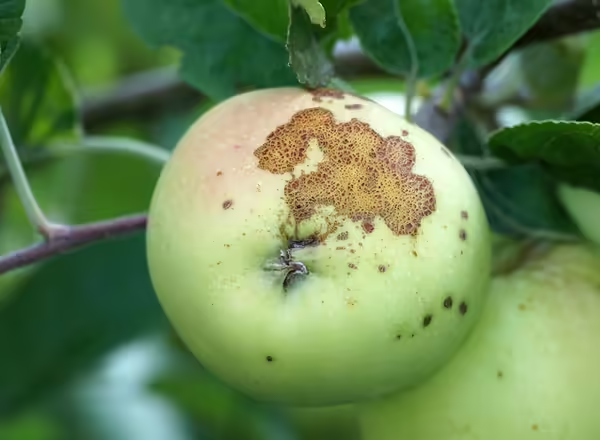
San Jose scales overwinter as nymphs and begin feeding again when sap begins to flow in the tree. Female scales continue to grow and give birth to young crawlers about 3 weeks after petal fall. There are two to three generations in northern Illinois and four to five in Southern Illinois. The young crawlers feed on branches, leaves, and fruits, causing red, spotted areas. Infested leaves usually drop and branches lose vigor and die. Fruits will have an undesirable finish because of the red, spotted appearance caused by scale feeding and the presence of the scale.
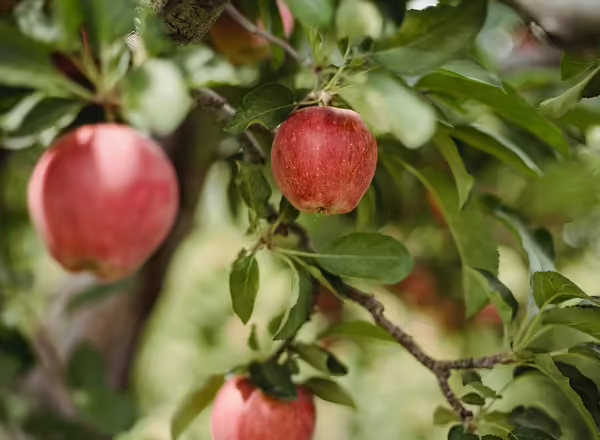
Apple maggot mainly infests apples but may also attack plums, blueberries, and crabapples. It passes winter as a pupa and adults emerge from June to September. Adult flies have dark bands on their wings and white bands around the abdomen; they puncture the skin of the apple and insert an egg into it. Egg laying can occur from mid-June to mid-September. Tiny legless maggots hatch from the eggs and feed by tunneling throughout the apple flesh, leaving tiny brown trails. Egg punctures and larval feeding cause fruits to be dimpled. If the fruit is soft, it will soon rot. Apple maggots are common in northern Illinois but are not found in the southern part of the state.
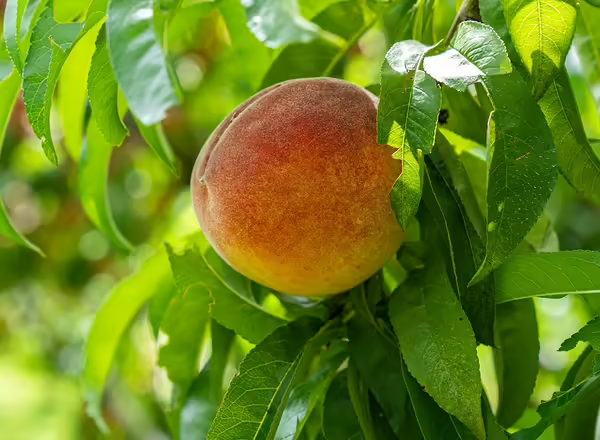
Peach tree borers and lesser peach tree borers attack the trunk and branches of trees of stone fruits, especially peach trees. The peach tree borer attacks the inner bark from about 12 inches above to about 3 inches below the ground level. Lesser peach tree borer injury may occur anywhere on the trunk or branches where larvae can get under dead bark. Both species winter as larvae under damaged bark. Adults emerge from these wounds from about mid-May through September. The moths lay eggs on rough areas of bark and young, hatching larvae must be able to get under loose bark for protection. There is usually one generation a year in Illinois for the peach tree borer and about one and a half for the lesser peach tree borer.
Other borers such as shot-hole borers may attack dwarf apple trees containing an interstem dwarfing piece. Flat-headed borers (shown below) and round borers may attack weak apple trees of all types. Trees damaged by borers are more susceptible to cold injury and perennial canker than healthy trees.
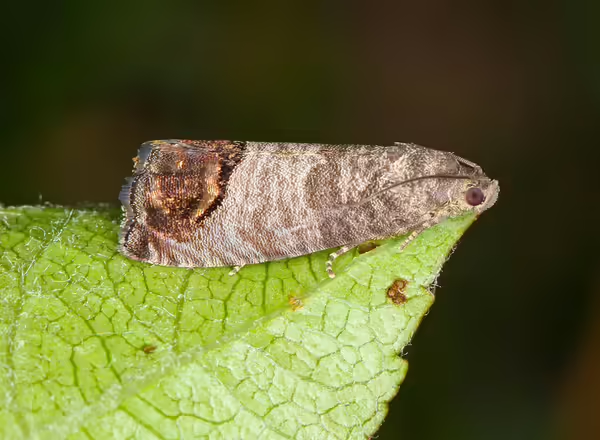
Codling moth is a serious pest of apples. It over-winters as a larva behind loose bark on the trunk of an apple tree. The moths emerge in late spring and lay eggs on leaves and fruits soon after petal fall. There are two and sometimes a partial third generation in Illinois. Larvae damage apples by chewing their way into the center of apples. “Frass,” or fecal material, is pushed out through the opening in the apple skin. The tunnel through the apple is an avenue for disease to attack the fruit, causing it to drop.
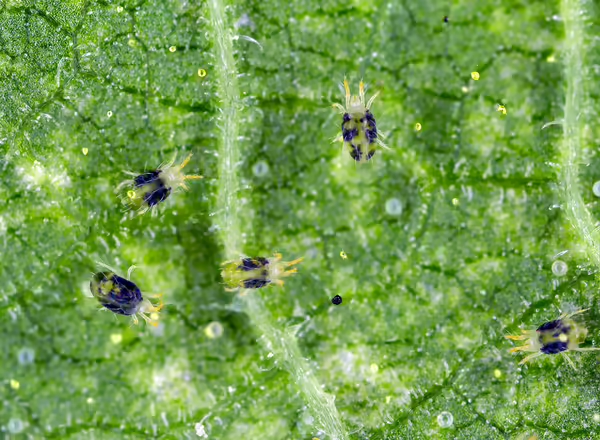
Two-spotted spider mites, as well as European red mites and four-spotted spider mites, are severe pests in orchards, especially on apples. Mites are small, eight-legged animals about half the size of a pinhead. Use a magnifying glass to look for them on the undersides of the leaves. Usually, they can first be found on leaves near the trunk, later moving to leaves on other parts of the tree. They suck juices from leaves, causing yellowing and finally bronzing of foliage. Hot, dry weather favors their development. Special miticide chemicals are usually necessary for mite control, although insecticidal soaps and forceful water sprays can significantly reduce mite populations on a small scale.
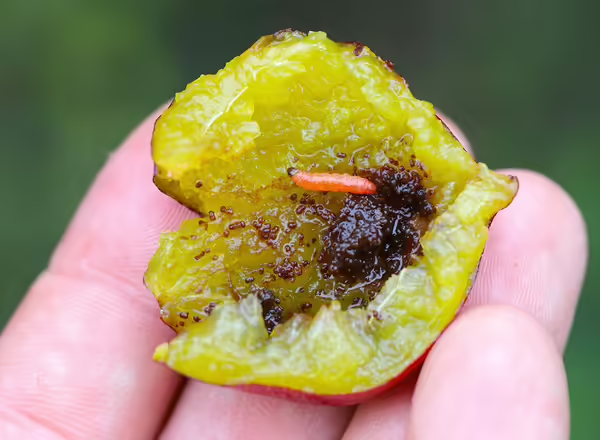
Oriental fruit moth larvae are a common pest on peaches and nectarines. First generation larvae tunnel into the ends of new shoots, causing dieback or flagging. If fruits are available, succeeding generations enter and feed in them. Larvae feeding in fruit cause the fruit to drop. The wounds also serve as avenues for rots to enter the fruit. There are four generations in the central part of Illinois with a partial fifth generation in the southern part.
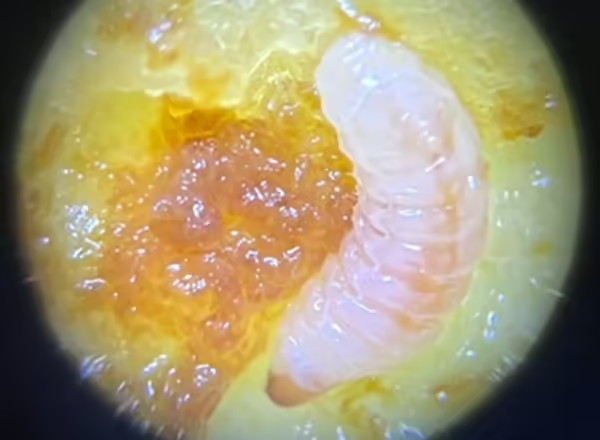
Plum curculio attacks a number of fruit species, including apple, peach, plum, cherry, pear, and apricot. It winters as a dark brown snout beetle in wooded areas near orchards and becomes active at blossom time, feeding on newly forming fruits. Eggs are laid on crescent-shaped flaps cut in the skin of young fruits. Hatching larvae will tunnel through fruits of peaches or plums, causing the fruits to drop or rot. Such cuts on apples give an undesirable finish to mature fruits but curculio larvae seldom live in apples.
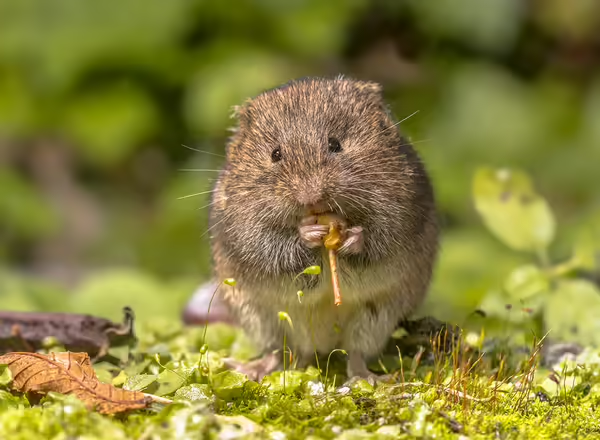
Mice and voles are serious pests of apple trees, and frequently damage other types of fruit trees as well. All ages of trees may be attacked. Meadow mice and prairie voles cut the bark (including the inner- bark) from the trunk and roots, both above and below the ground level.
Pine voles nest underground, eating the bark from the roots as well as the lower trunk. Trees badly damaged by voles usually die the following summer.